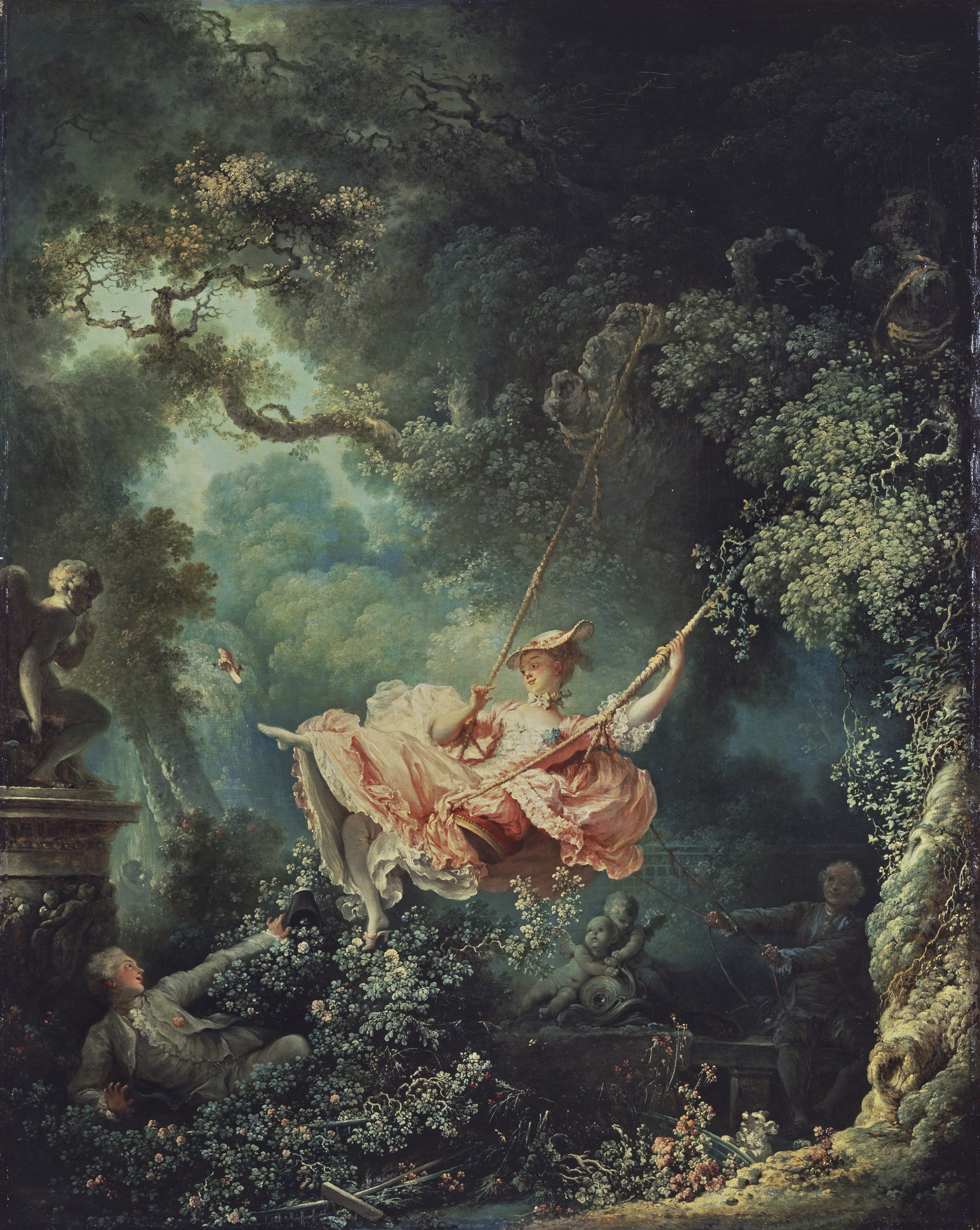Features of Rococo art
In the Rococo period, painting was delicate and finely detailed, which would later become criticized despite it's intricate curvilinear shapes and perfect finishing, complete with rich and luxurious fabrics and beautiful backgrounds. In a way, this was the complete opposite of what the Baroque artists were attempting to achieve. However, the marks of a rococo painting are shown in soft brush strokes, reflective of the wealth and royalty of French court.
Key Artists
Jean-Honore Fragonard is an example of an artist that would paint the high society of the French court, his most famous work being The Swing (Les hasards heureux de l'escarpolette) painted in 1767 using Oil on Canvas which made him popular with the aristocrats of the court. His figures are prominent in their rosy cheeks, exposed body and 'passionate' embraces as shown in The Swing. This painting shows the lifestyle in which they live, the girl is being pushed on the swing by her husband while her husband sits in front looking up her skirt.
 |
| "The Swing" by Jean-Honore Fragonard, Oil on Canvas, finished in 1767. |
William Hogarth
From the Rococo period, William Hogarth became a vital name for his crucial theory on the 'Serpentine Line'. In the William Hogarth book, "The Analysis of Beauty" from 1753. In the book, he describes how the way to fix art would be to stop the "fluctuating ideas on taste". He claimed that the Serpentine Line was of optimum beauty, with nature's observation being the "cornerstone of artistic practice". We should be pleasuring the eye with a sense of variety according to Hogarth.
How did the Rococo period end?
The French Revolution effectively ended the French rule of Louis XVI and the political climate that Rococo art revolved around. The end of this rule was brought about by revolts that effectively ended the French monarchy and put Napoleon in place. This period of art was quickly marginalized, claimed to be far too based on ornamentation and wealth, very simple and sentimental themes. The art that would later become favoured would be the styles of Neoclassicism and the art that came out of the Age of Enlightenment. Some writers and critics, such as Voltaire, also regarded the period of art as being too superficial and later becoming "degenerate". Neoclassicism would be what replaced Rococo art in France.
The degenerative qualities of the Rococo period as seen in the later half of the 18th Century are illustrated in the image above, "Simplicity" by Jean-Baptiste Greuze, painted in 1759. The images theme is purely sentimental and is based on it's emotional value of the young girl rather than the higher regarded portraits of aristocrats such as Madame de Pompadour earlier in the period. The work is vey soft and plain, generating very little interest. Greuze himself has often been accused as an artist of overt emotion, unnatural and poor composition and unattractive colour schemes and palettes.
Ultimately, the Rococo art period of history is one that is closely tied with the society of the time and the political climate, influencing the artwork directly. It's themes do not often differ from the subject matters of wealth, luxury, status, sexuality etc. all aspects of French life being exploited in the court by Louis XV and the monarchy itself. It's criticisms as a movement of art are more wide ranging than most throughout history, from the twisted portrayal of emotion, the lack of dynamic in subject matter and the degeneracy and overall decorative qualities that were later rejected after the French Revolution in 1789 to 1799.
"Simplicity" by Jean-Baptiste Greuze (c. 1759).
|
The degenerative qualities of the Rococo period as seen in the later half of the 18th Century are illustrated in the image above, "Simplicity" by Jean-Baptiste Greuze, painted in 1759. The images theme is purely sentimental and is based on it's emotional value of the young girl rather than the higher regarded portraits of aristocrats such as Madame de Pompadour earlier in the period. The work is vey soft and plain, generating very little interest. Greuze himself has often been accused as an artist of overt emotion, unnatural and poor composition and unattractive colour schemes and palettes.
Ultimately, the Rococo art period of history is one that is closely tied with the society of the time and the political climate, influencing the artwork directly. It's themes do not often differ from the subject matters of wealth, luxury, status, sexuality etc. all aspects of French life being exploited in the court by Louis XV and the monarchy itself. It's criticisms as a movement of art are more wide ranging than most throughout history, from the twisted portrayal of emotion, the lack of dynamic in subject matter and the degeneracy and overall decorative qualities that were later rejected after the French Revolution in 1789 to 1799.


0 comments:
Post a Comment